 |


|
Okinawa Trip 2014
|
| Some journeys that we take are learning experiences, emotionally lifting or a combination of both. This year's trip to Okinawa was a trip that combined every definition of a journey not a trip. For many, it was acheiving the goal of one's karate lifetime by visiting the "Mecca." For others it was establishing or reaffirming friendships amongst the group as well as on the island. For me, it probably was as much of emotional closure as it was a need to "lock elbows" with my seniors and redefine our committment to the Butokukan and it's future. The greatest thing that the Butokukan offers is not it's karate but the belonging to a family. I think I speak for everyone in our group that the closeness that exists between all of the senior Okinawa members and the members from abroad is a true bond. When we travel to Okinawa, it is symbolic of any family. There are bonds, affection, sometimes arguements, brotherly instigation, bruises, but always a reassurance of our relationship. |
| Friday June 27
The flight coming over from Houston was a disaster.Unfortunately, the lady who sat next to me was sick and with no exaggeration, coughed horribly about 6 times per minute-for the entire 12 hour flight. Finally the stewardess made her put on a mask which only created an echo.....
We arrived at Narita with no issues and a fairly easy navigation of the group through immigration and customs. We made a quick stop to the kaiten sushi restaurant on the 5th floor and then headed down to the terminal for the flight to Okinawa.
As luck would have it, we had an American couple behind us with a toddler that screamed the entire flight to Okinawa. This kid had a set of lungs that would rival any heavy metal singer and he used them non-stop to Okinawa.
Once in Okinawa, we were warmly greeted by Gibu Sensei, members of the Butokukan as well as my exchange student Rio Yamazato. After pictures, we loaded everyone and their bags in the bus hotel and Izumi Sensei headed us in the direction of Koza. Izumi Sensei brought the bus around and with great team work, we got all of the baggage and their owners packed in for the ride to Koza.
We arrived at the Deigo Hotel and got quickly checked in so that we could head to our traditional first meal with the Kyans at the Lemon Grass. We were greeted warmly and sat down for the usual course of delicious appetizers and Okinawa dishes. We stayed until about 1 am and then headed back for our usual gathering on the rooftop for Naihanchi Kata and beer. None of us had any difficulty sleeping.
|
 |
|
 |
|
Most of the guys woke around 5:30/6:00 and took off for a morning run and Crossfit/Yoga session to fight off jet lag. Izumi Sensei drove Joe and I to Fuji Rent A Car to pick up one of the two vans that we would be using for the trip. Upon returning, Izumi Sensei left for work and we headed down to Tomari to Shureido. All first timers to Okinawa have to see and do certain things, and so we made our first stop to Shureido so that everyone could stress themselves out by deciding whether they wanted to eat the rest of the trip or spend most of their money on all of the great things in the store.
After everyone christened themselves with the Shureido shopping spree and a major dent to their trip funds, we began to head to Shuri Castle when we made the correct call that we would not have enough time before we had to meet Gibu Sensei at the Hombu dojo at 1:30. Joe navigated us to the Naha Mall and we all went our own way for lunch. I ended up being surprised by Rio (my third "daughter") who works in the Starbucks on the first floor and saw us walk by.
|
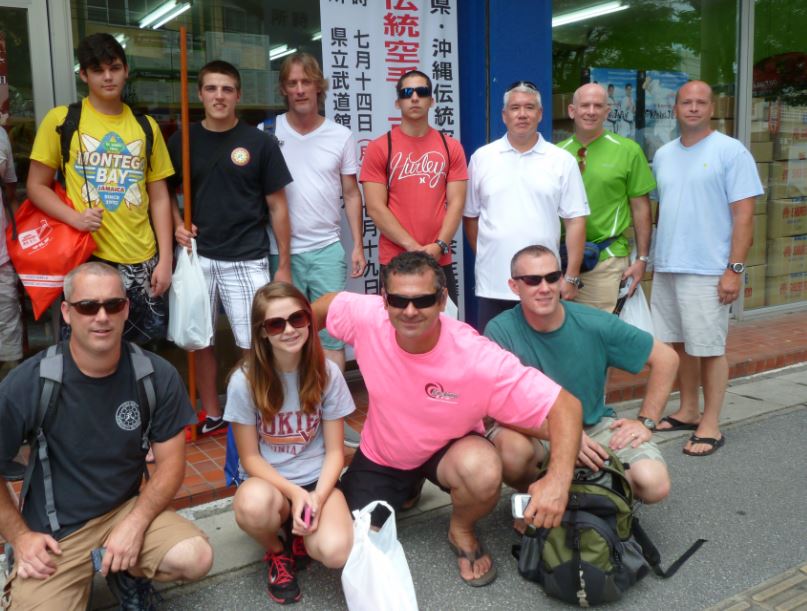 |
|
We made to the Hombu Dojo where we met Gibu Sensei and then followed him in his car to the Urasoe Community Center. There we had an incredible demonstration by the troupe of Urasoe’s elementary and middle school Taiko/Eisa core. Maikawa Sensei is the head teacher for this group and also the Naha and Ginowan troup, all which have over 250 members that demonstrate around the world and for many events on Okinawa.
|
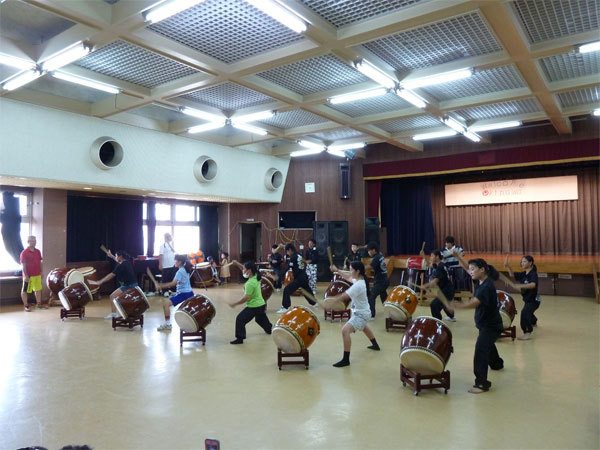 |
|
One could see the obvious parallels with taiko/Eisa with karate and there were even Pinan kata postures that were used in many routines.
The children were amazing and very enthusiastic about their performances. After their practice, Marissa was asked to demonstrate karate and kobudo and then we were all invited to try our hand at Taiko.
One of my favorite performances of any Okinawa trip is watching shishi mai(lion dances) and the middle school students performed a dual performance. For those of you who have not seen it before, it requires a tremendous amount of rehearsal and agility for the performers under the costume. If you are "bitten" during the performance, it is said that you will have good luck!
|
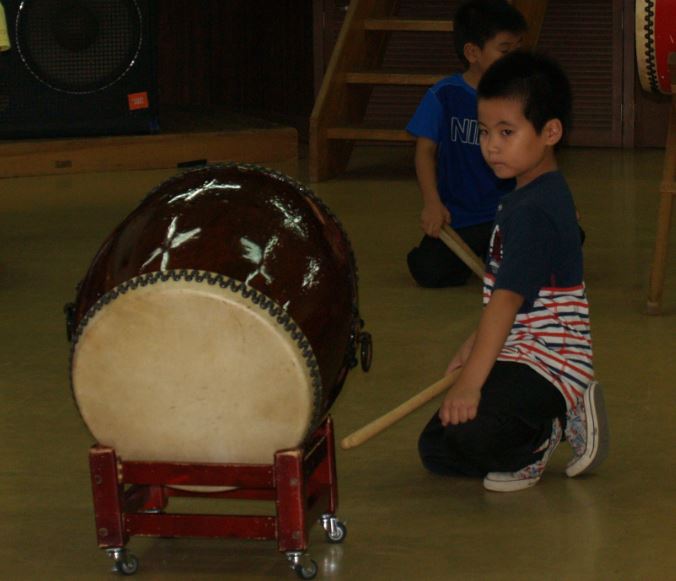 |
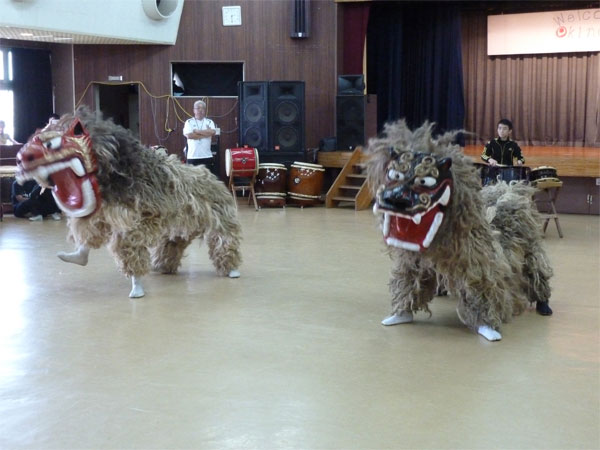 |
|
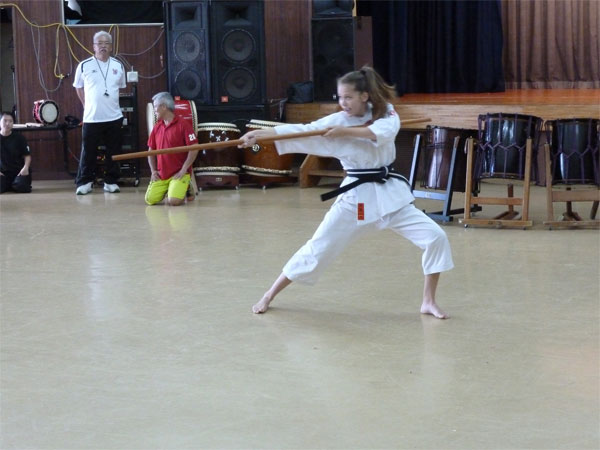 |
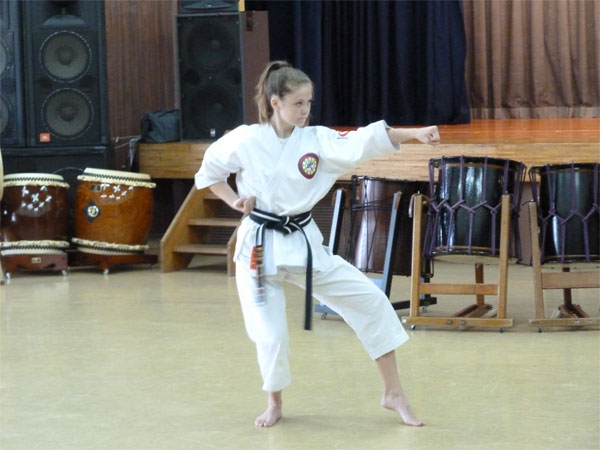 |
|
|
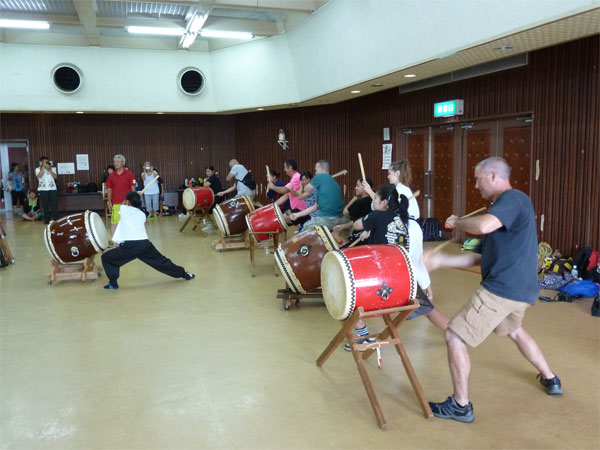 |
|
|
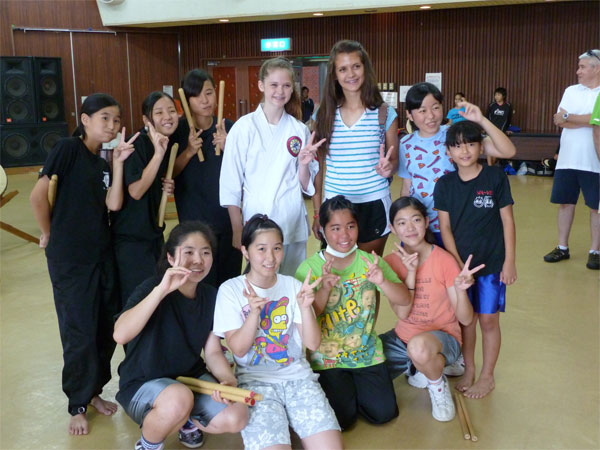 |
|
|
|
That evening, Gibu Sensei and the Butokukan members threw us a kangeikai and we were treated to an opportunity to catch up with friends and seniors. Daigo Sensei's son Taisai was the MC "vice president" and read in English his father's welcome speech.
We had more food than you can imagine and the evening was filled with many speeches, introductions and humor. The party eventually came to a close and went to Maekaru san's house where he has a dojo for taiko. They also meet there to make the costumes and store a lot of the props and supplies.
|
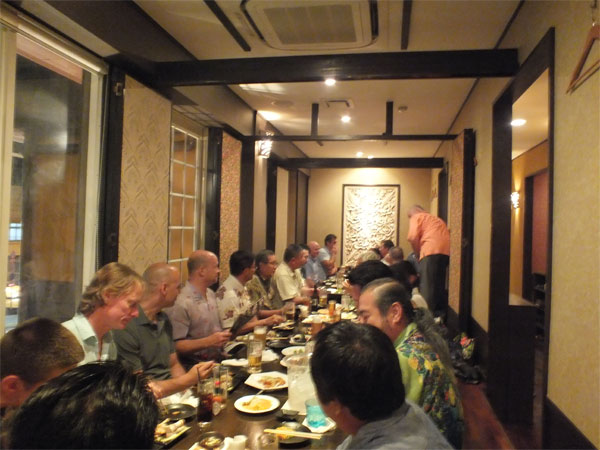 |
|
|
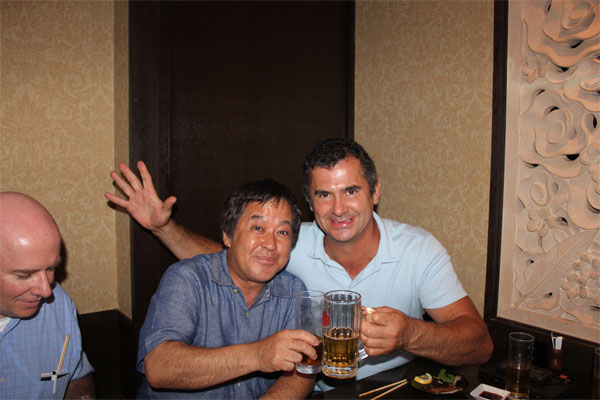 |
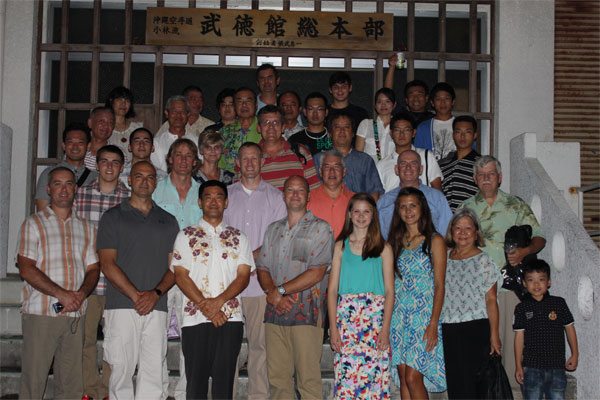 |
|
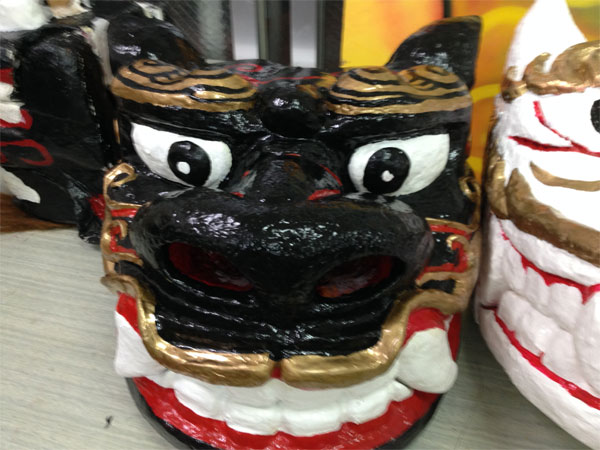 |
 |
|
Sunday June 28


Monday June 30

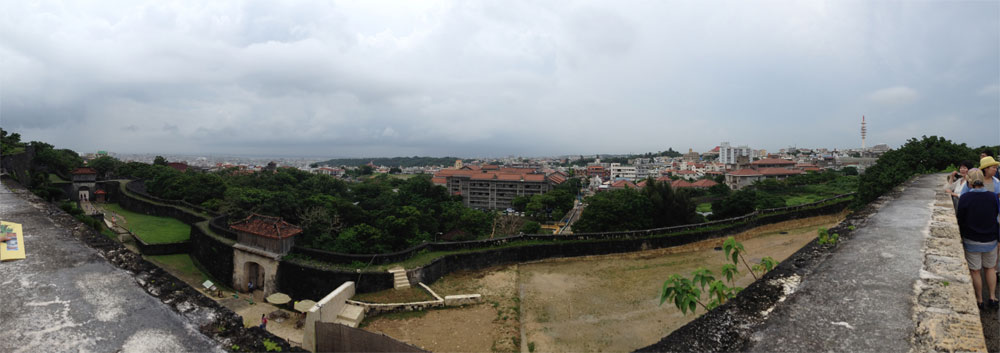
| No matter how many times you see Shuri gusuku, it's beauty is still captivating. I still remember my first visit to the castle in 1999 and how my heart beat as I saw the first partial view of the courtyard from the hosshimon(the three gates). |
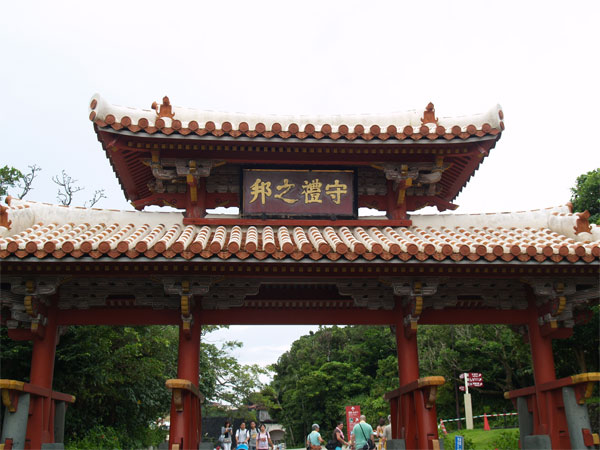 |
|
The Romanian Godzilla attacks......
|
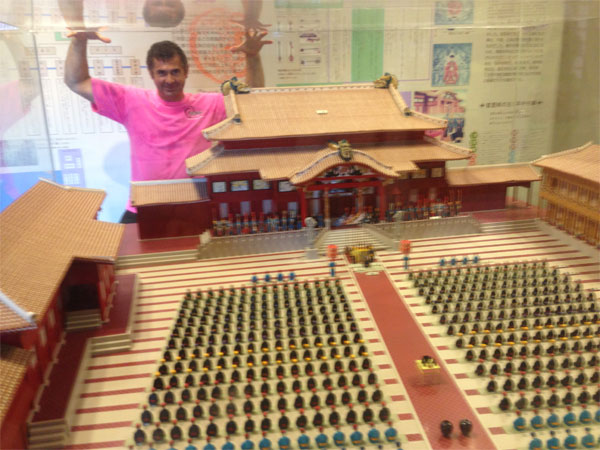 |
| After Shuri Jo, Izumi Sensei drove us to Tomari Minato so we could see the local catch and get lunch. We were all famished and took our time to sample the wonderful examples of Okinawa seafood cuisine available. Brian Doherty and I attacked the raw oyster kiosk and being from around the Chesapeake Bay, were forced to question our alliance to our local seafood. The oysters were perfectly salty with a mild buttery flavor and for the price, well worth the money. |
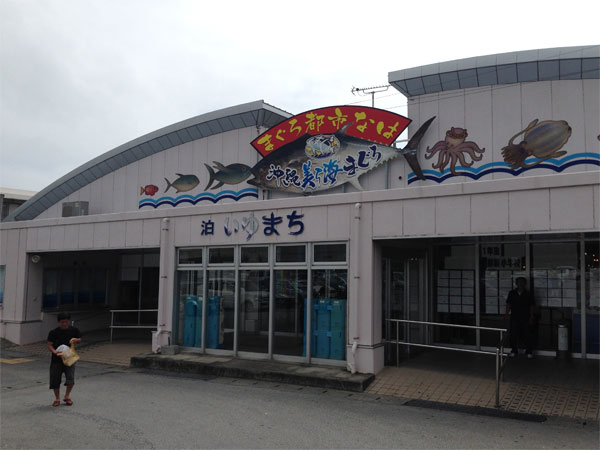 |
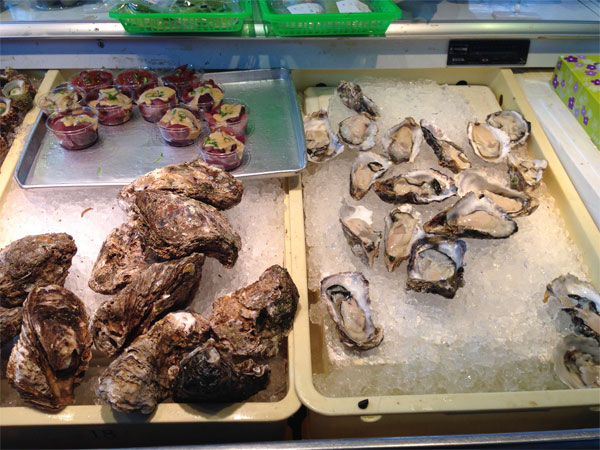 |
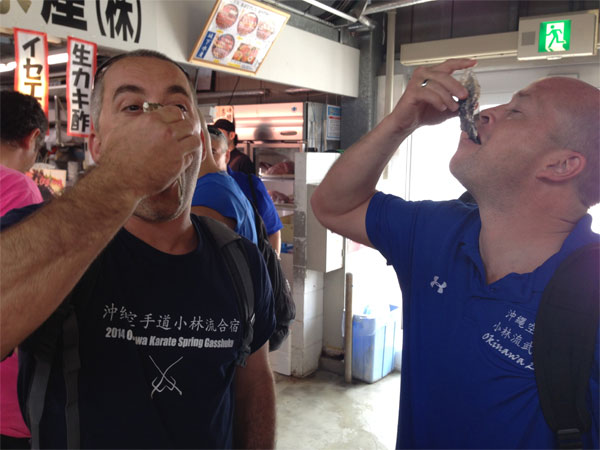 |
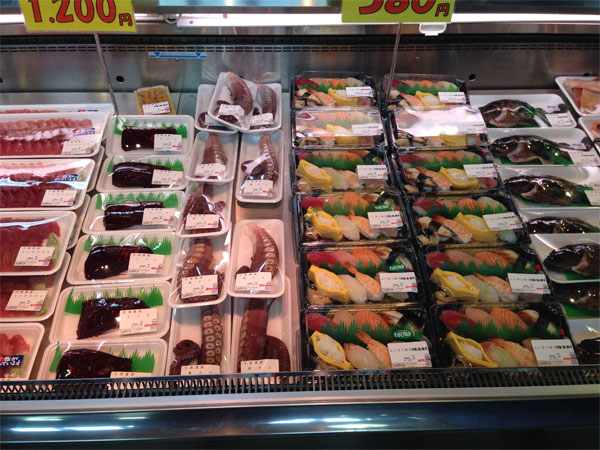 |
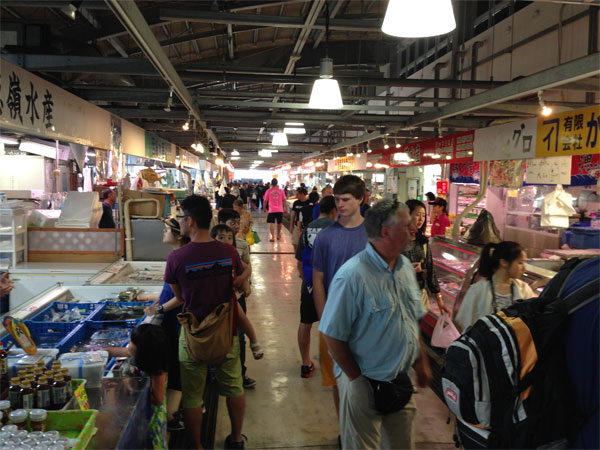 |
|
|
| That evening brought the first official practice at the Hombu Dojo in Urasoe City. Gibu Sensei welcomed everyone and after a short speech, took us personally through each exercise, as did his father. We used Gibu O'Sensei's personal junbi undo, yobi undo and then went through the kata so everyone could be checked. Kata training is always the heart of training and although other things are taught, kata says a lot about a student.
While kata alone is not the end-all of training methods, it allows for teachers to see strengths and weaknesses within their students. A student's ability to perform kata with the proper tension, weight distribution, speed variation, and correct strength mechanics are some of the many things teachers look for when watching.
|
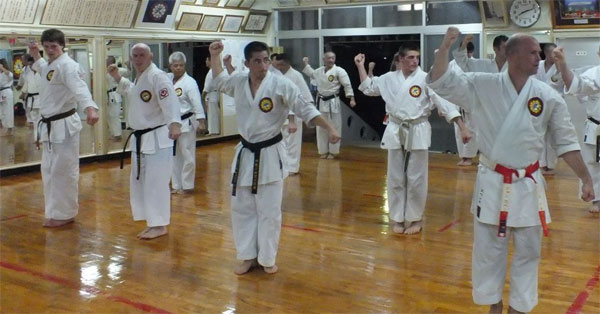 |
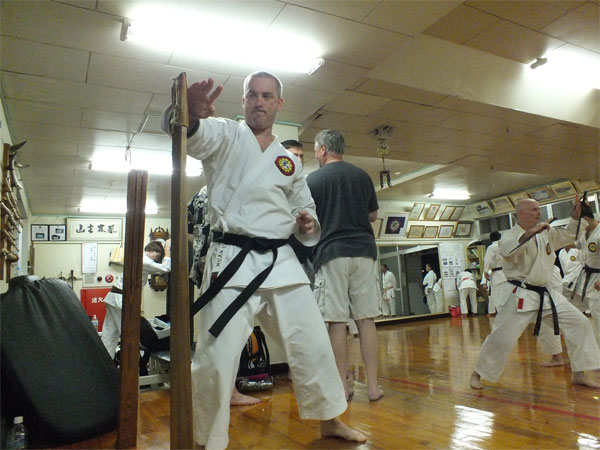 |
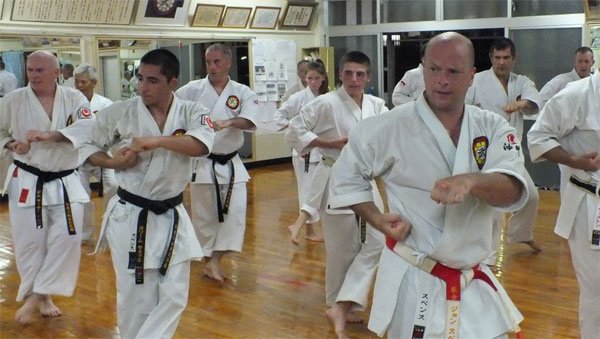 |
| After training, we did the best to clean up the lake we created on the dojo floor and we were treated to a wonderful meal at a restaurant behind the dojo. Gibu O'Sensei always acted like a parent and made sure we were never hungry and his son and our seniors continued that tradition. Tamaki Sensei kept ordering everyone to choose more food from the menu and even when we couldn't possibly fit anything else in our stomachs, he would order something else for us.
This is one of the many special examples of how the Butokukan is a family. Our Okinawan family members are always looking out for us whether it is at a meal, seeing a special demonstration of Okinawan culture or just pushing us physically on the dojo floor. In the Butokukan, although there is a heirarchy in the dojo organization, everyone is treated like a family member. The most senior people treat the lowest ranking member or visitor like they are just as important as the senior group. Unfortunately, other Western teachers create walls around Okinawan teachers that only they and a few can climb and leave students to only watch from the grass.
|
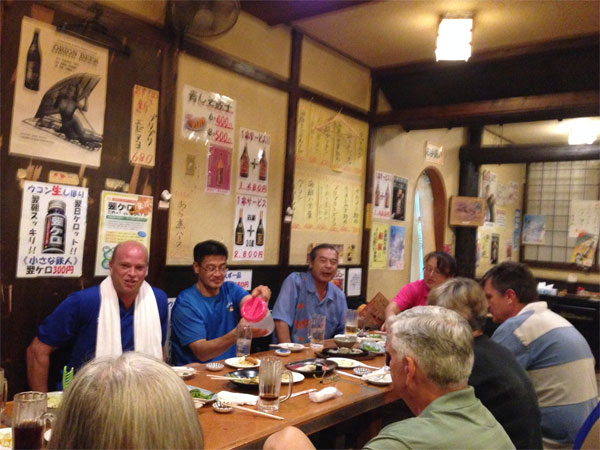 |
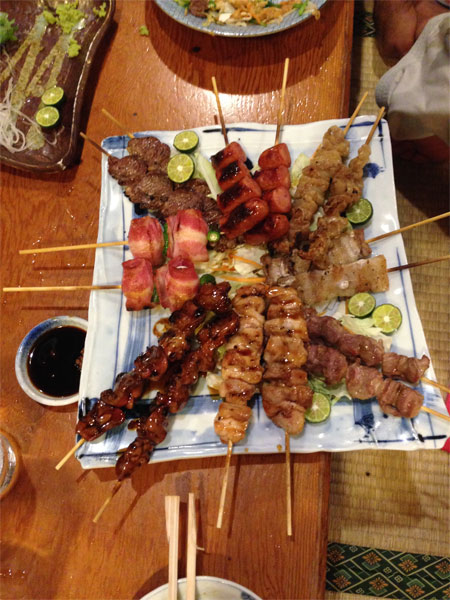 |
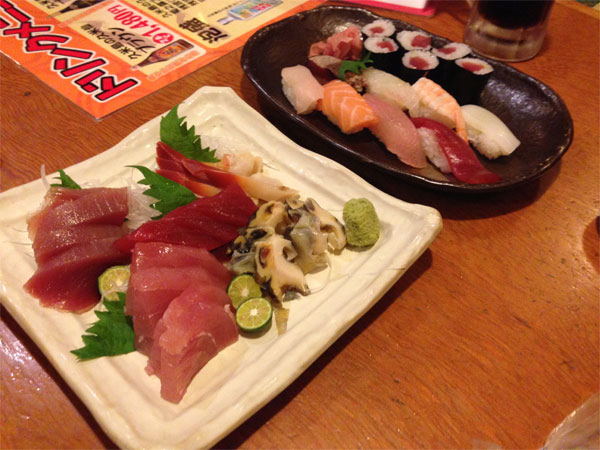 |
|
|
Tuesday June 1st
| Aragaki Sensei contacted me before we left the States and asked if I would like to receive a shodo lesson from her sister who is a 8th dan in calligraphy. After speaking with her at the Taiko demonstration, I asked if there was a way that I could include everyone. Gibu Sensei first suggested the hombu dojo which I humbly squashed that idea as the thought of black sumi ink on the dojo floor raced through my mind.
Aragaki Sensei contacted her sister and it was arranged for us to use the Tomari Keinokan near Shureido where the Tsuna no Hiki (Tug of War) practices are held for that area.
During the hour session, we were each allowed to try a number of sayings related to not only karate philosophy but life in general. Everyone was very grateful for the experience and many students purchase some of Sensei's personal shodo that were on display.
|
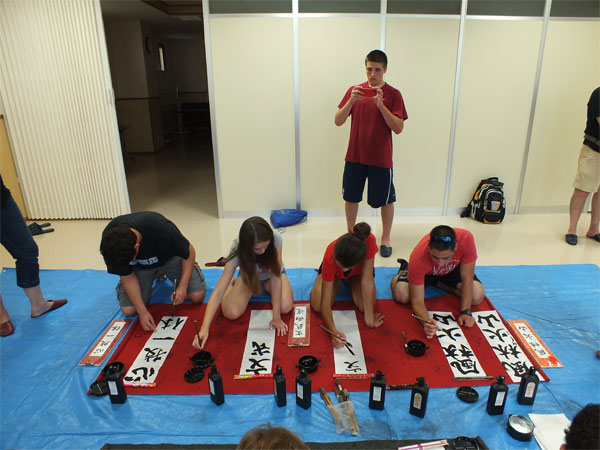 |
|
|
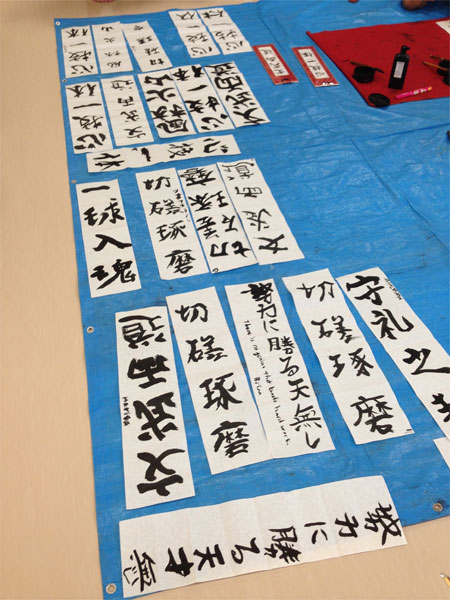 |
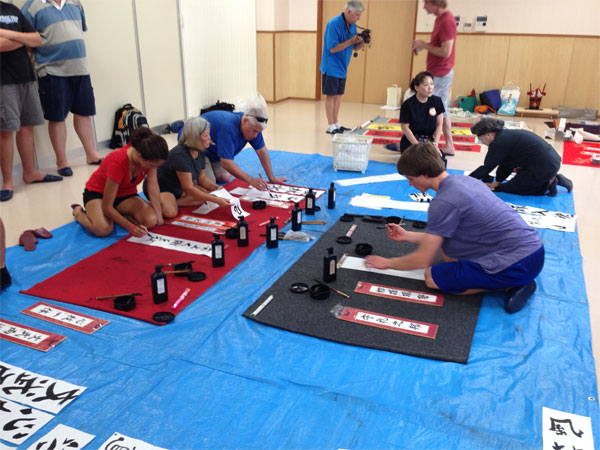 |
| Jet lag began to take a toll on everyone's stomachs and after a meal of soki soba, Joe took everyone back to the hotel to rest for the evening's kumite session. Joe, Jeff and I left for a special meeting with the Urasoe City Mayor and the Butokukan members.
Mayor Matsumoto, 43, was a very charismatic man with very strong English speaking skills which he gained from living in California for two years. He was interested about our travels to Okinawa and seemed very appreciative that we spend as much time learning about Okinawan culture as we do training in the dojo.
|
|
| Tuesday has always meant kumite in the Hombu Dojo. As I have said before, the Butokukan dojo is a spartan dojo. When it comes to kumite, that is one of things O'Sensei's legacy is known for in the past and present. Gibu Makoto Sensei has always taken kumite as a very specialized area of training and his personal training regiment is always leading by example. It was interesting to see that on the trip, Gibu Sensei had a slightly different warm up for the different content of each class. Kumite night had more cardiovascular and limbering up sort of work whereas kobudo night involved more working on joint preparation.
Having been a participant on a number of Gibu Sensei's kumite workouts, it was a brutal cascade of constant movement and definately pushed us all to our physical limits and beyond. Although still a young man in Okinawa terms, Gibu Makoto Sensei is in his top physical form. One would think that his younger years as a full contact champion would be behind him but I saw an even stronger and more fit teacher than I have trained and fought with before. He truly exemplifies how all teachers should be-training harder than your students.
|
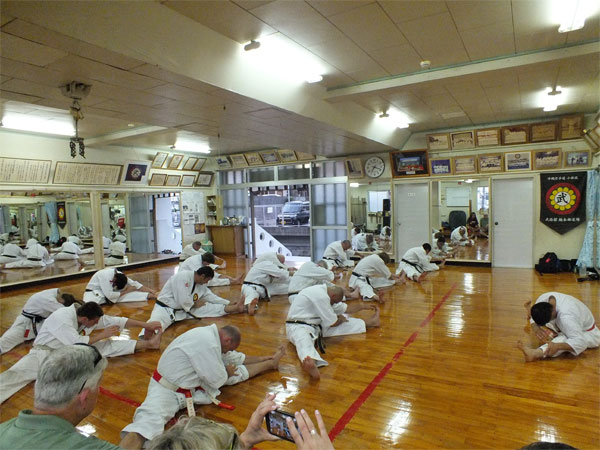 |
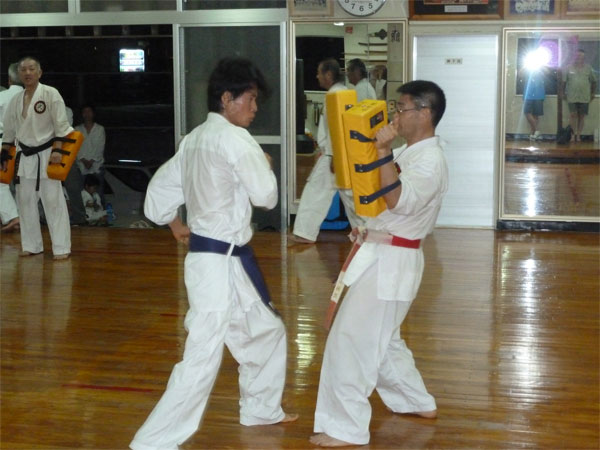 |
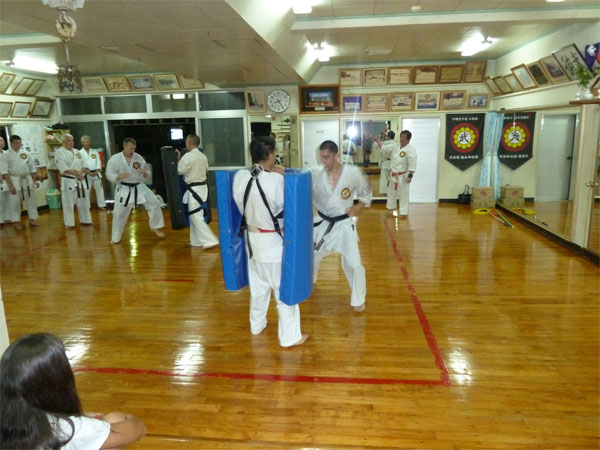 |
|
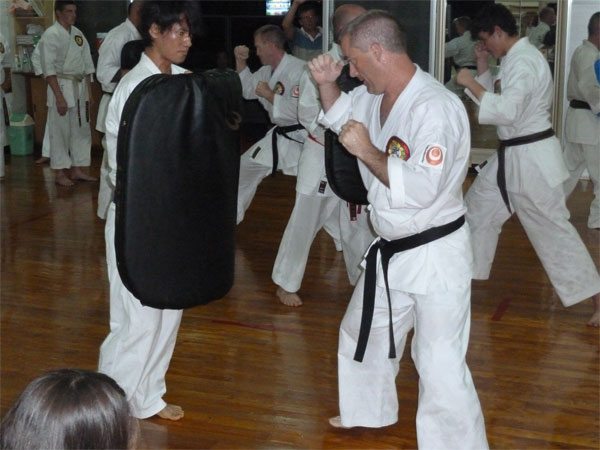 |
| After lots of bag work, up and down the floor, the allotted time for class ended at 9:30. Normally, the dojo is then open until around 10 or 10:30 for free practice but something was different this evening.
Through the haze of dehydration and sheer exhaustion on my part, Gibu Sensei told me that we were all going to go see his bo teacher. What??? Here was something I wasn't expecting. Gibu Sensei was being cryptic about things but told me that he trained every Tuesday with his bo teacher in Urasoe and that we were going to go see the practice. Unsure of what was going on, we waddled in our soaked gis to the bus to go to our unknown destination and event.
I have to say that at the time of this writing, I am still dumbfounded at the next hour. This was a real curve ball and I did not understand what was happening so I had no answers for my students. "Just get in the bus and we will figure out what is going on."
We drove to a small, backyard lot near the Urasoe City Hall and still confused, exited the bus to the smells of burning mosquito repellent and one spotlight illuminating a small area in someone's backyard.
It was only until I caught a glimpse of a familiar face from Chris Wilson's Karate Masters Photography project that I began to lose all control of my polite language and started to run towards the figure holding a bo.
|
 |
|
As it turned out, Gibu Sensei has been as student of Tomimoto Yukou Sensei, one of the only teachers of Maeda Bo on Okinawa. Every Tuesday, about 10 students gather at this small grass lot to train with Tomimoto Sensei under the stars. After brief introductions, Tomimoto Sensei began to demonstrate arching movements with a very heavy bo that seemed to cut through the heavy humidity. He then asked me to execute a few strikes towards him and demonstrated very quickly the effective circular attacks/counters that are used within the curriculum. Afterwards, Tomimoto Sensei then asked if someone from our group would demonstrate some of our kobudo and Kareem performed Kubo No Kun. As a teacher, we are all hard critics of our students but I can't remember ever being so proud while watching his demonstration.
Tomimoto Sensei then had one of his English speaking students demonstrate the basic kihon of Maeda bo but don't let me mislead you, they were only kihon by name. The sheer speed and power that was demonstrated cannot be described and again, these were not toothpick bos that so many use to hide their poor bo skills. These were tree trunk bos! He then gave us a history lesson on the origins of Maeda bo and how the techniques differed from other Ryukyu Kobudo. Never, mind you, did they ever talk of superiority over other systems, just how their techniques were different.
Gibu Sensei thanked his teacher for letting us attend and then told us that it was time to head back to the dojo for further training. I don't know how many flies I allowed to cohabitate in my dropped jaw but I can't remember the last time on Okinawa where I was held in a constant boyish giggle. I thanked Gibu Sensei for truly an unforgettable privilege that he gave us.
|
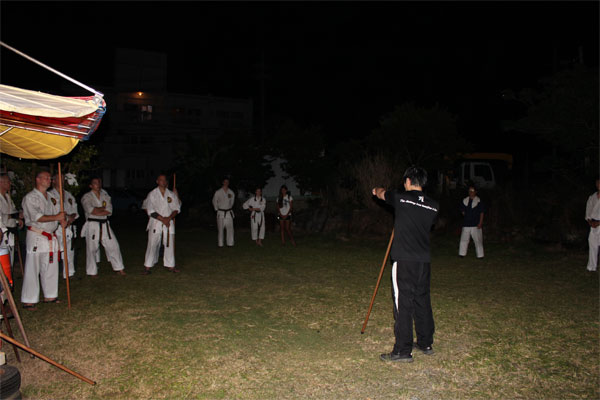 |
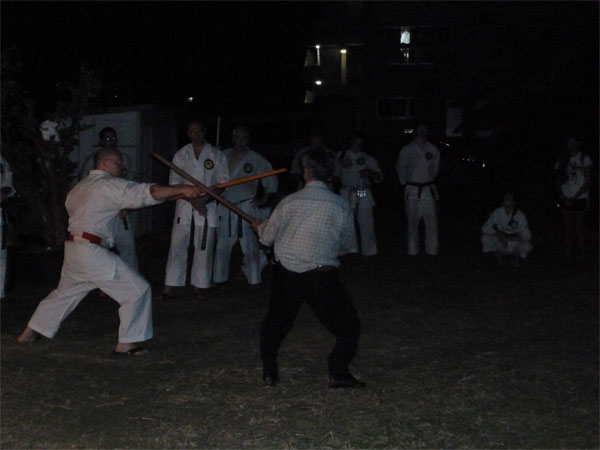 |
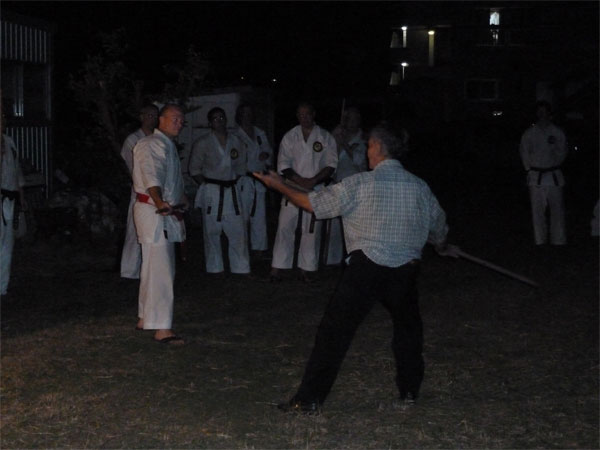 |
|
|
| Once back to the Hombu Dojo, the clock had been paused for the normal training period and we all paired up for kumite. We were all exhilarated from what we had just seen and seemed to have found a new energy to finish a night of sparring with one another. Izumi Sensei drove us home along the back way through Futenma which has hills that would make San Francisco proud. As he would make the roller coaster "chick chick chick" noise, 20 people would raise their hands and cheer as we sped at breakneck speed down the hill in a BUS! The simple memories are so easily forgotten. |
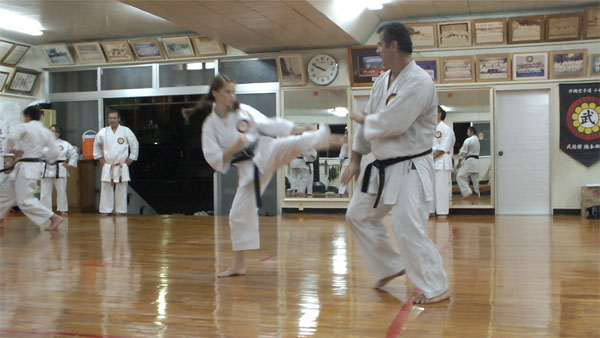 |
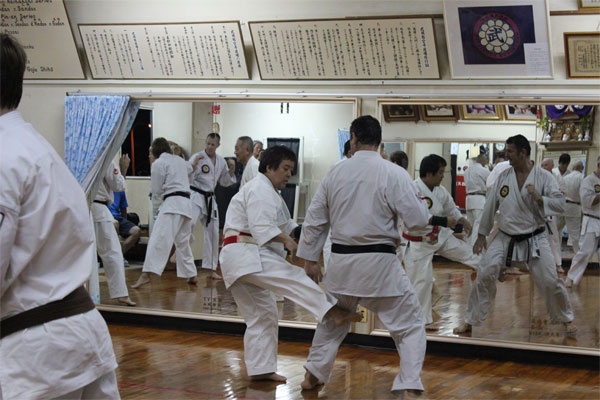 |
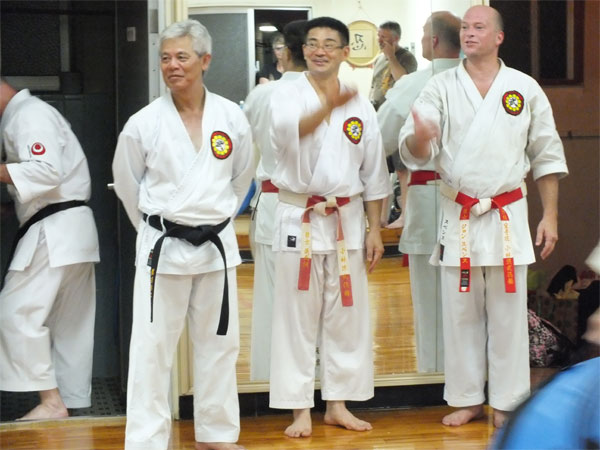 |
|
|
Wednesday July 2
| Sunagawa Sensei invited me to bring a few of our younger group members to visit her kindergarten class in Yogi and we had a fun morning listening to the children sing songs and having them make us countless pieces of origami.
We then joined up with the rest of the crew at the entrance to Heiwa Dori and let everyone have a couple of hours to explore the countless kiosks and shops.
A few of us made our way through Makishi market and after taking advantage of the many samples of food offered, we went up to the second floor to have a lunch of wonderful Okinawan food.
|
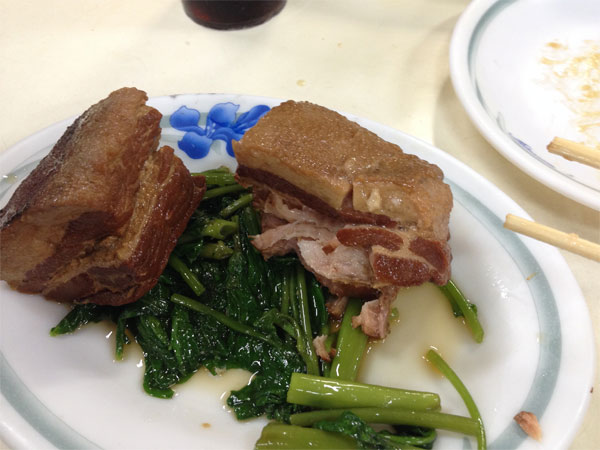 |
Ika Sumi-squid ink soup
Very tasty and good for the stomach!
|
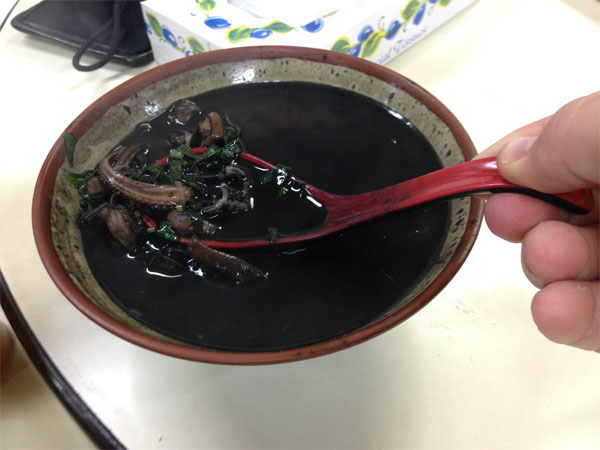 |
Koza Dojo

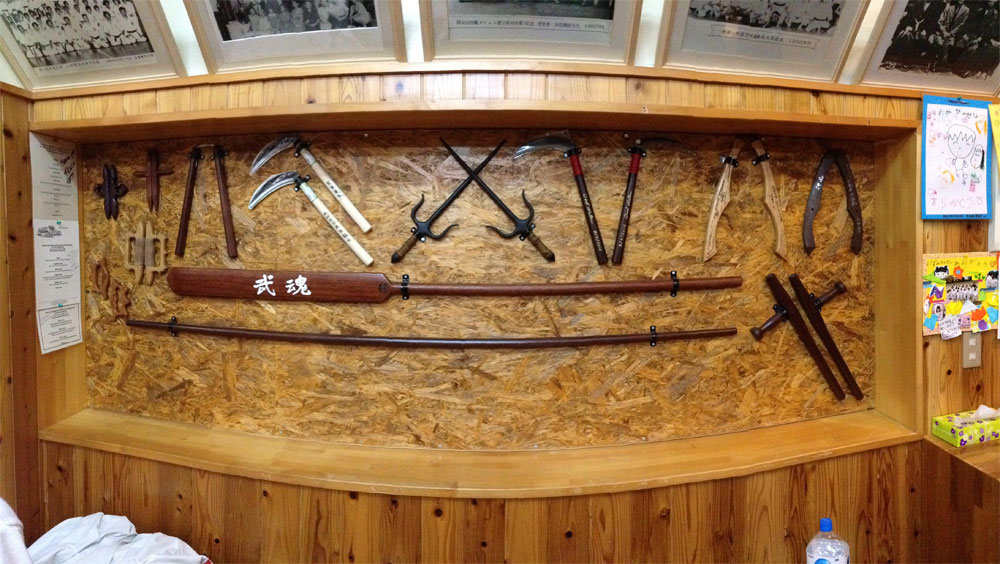

| After we were able to peel out of our gis at the hotel, Izumi Sensei had us meet him at his friend's izakaya next to the hotel for his own kangeikai for the group. As my older brother never misses an opportunity to mix humor in the sharing of his culture, the menu was laced with many exotic examples of Okinawan cuisine. Aside from the wonderful yagi(goat) sashimi, somen noodles cooked in squid ink and the basic steak/chicken plates, we (some of us) were able to have sea snake soup, whale sashimi and pig intestines. Keep in mind, some of the strangest sounding foods are many times the most delicious and they are also a part of someone's culture. So therefore, be adventurous, gracious and become a part of the gifts someone gives you. |
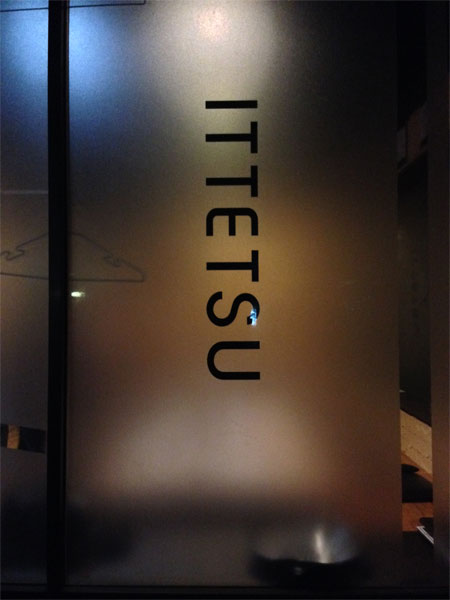 |
|
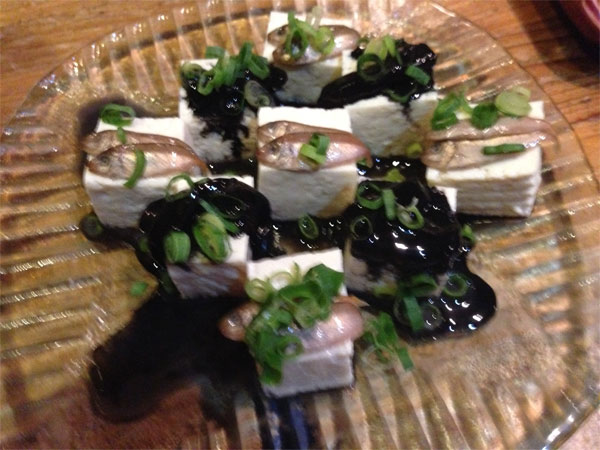 |
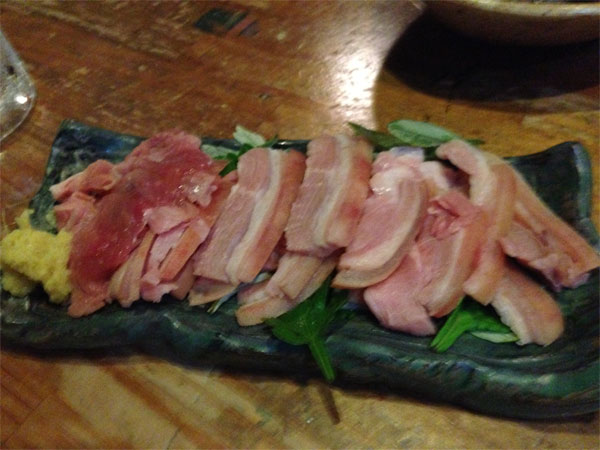
Goat Sashimi
|
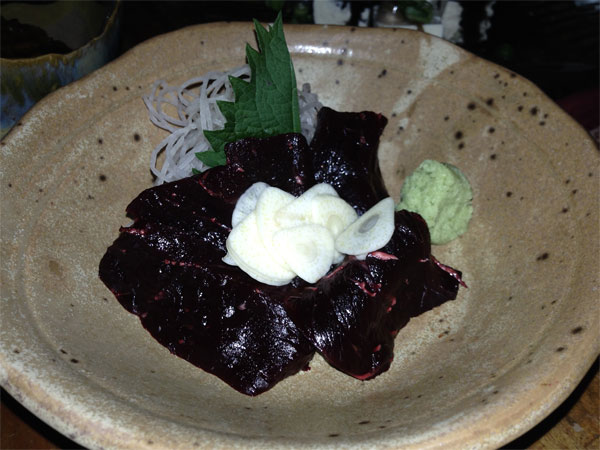
Whale
|
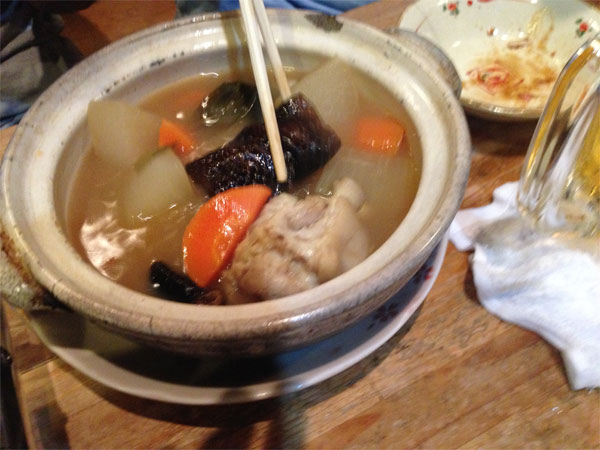
Sea Snake Soup
|
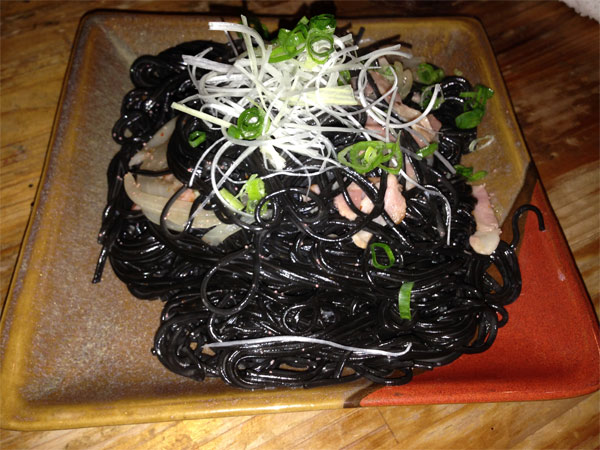
Somen with Squid Ink
|
Thursday July 3
Friday July 4th
| We headed off to Kubagawa, Shuri today to have a training session with Kinjo Masakazu Sensei, Hanshi/9th dan and his two incredibly talented sons, Satoshi and Kenta. Gibu O'Sensei was good friends with Kinjo Sensei and graciously arranged for me to visit him back in 2007.
My friend Miguel DaLuz met us with a visiting group of French university Shotokan team and we all got down to working on nunchaku basics and Kinjo Sensei's version of Maezato no Nunchaku called Kubagawa No Nunchaku. Although similar in pattern to Maezato, there are some differences in the techniques and we were all very excited to learn it.
|
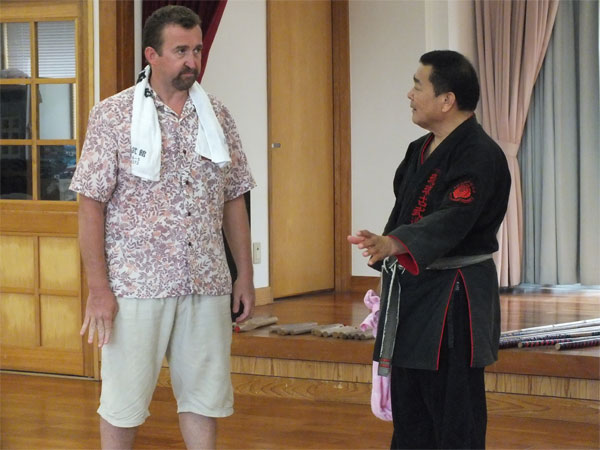 |
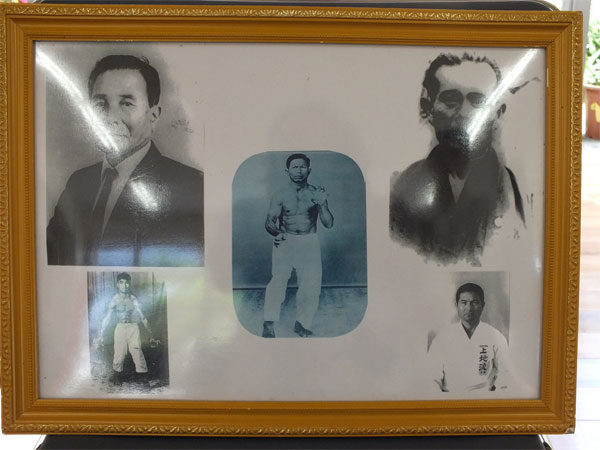 |
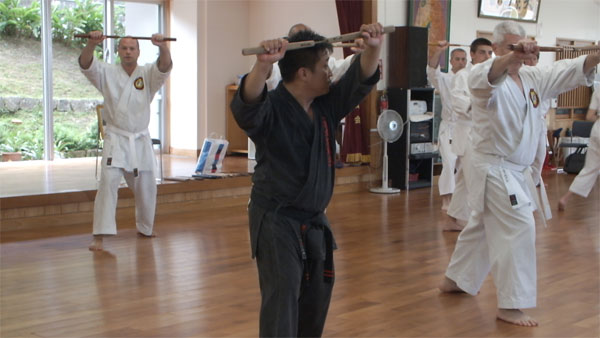 |
|
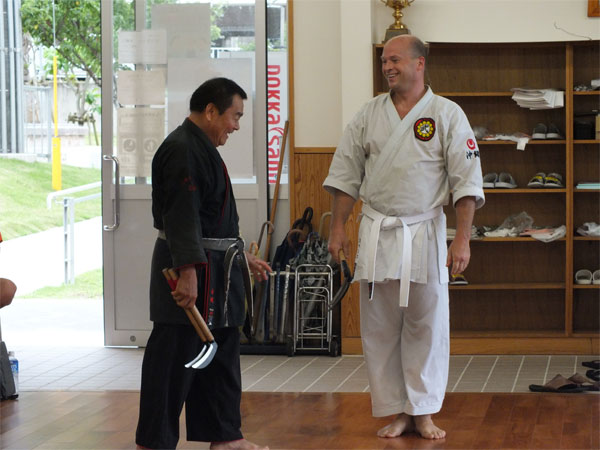 |
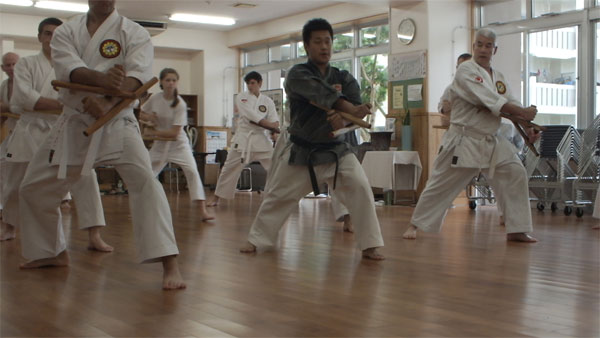 |
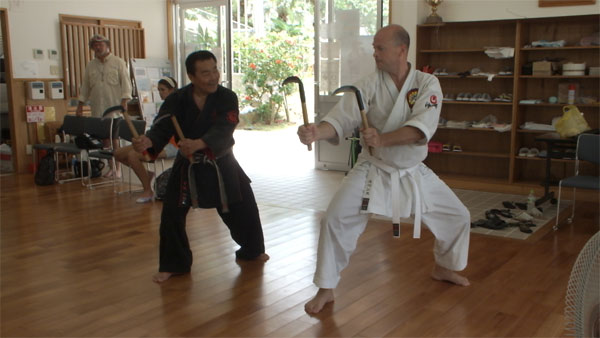 |
| After the first session of nunchaku was over, we broke in to smaller groups and the French group continued to work with Kinjo Satoshi Sensei while my students worked with Kinjo Kenta Sensei on Hama Higa No Tonfa.
Kinjo Sensei took me to the side and personally worked with me on Kanegawa no Kama. Kinjo Sensei is an amazingly open teacher who not only is very meticulous with details but constantly weaves in application so the student understands the muscle movement correctly. I was incredibly lucky to have Kinjo Sensei correct my kata as I had been doing many things incorrectly up to this day.
He then took a few of us who practiced Maezato no Tekko and corrected our kata while also showing us various bunkai.
|
 |
| One of the many treats of the training session was watching Kinjo Sensei personally restring my nunchaku. He had noticed that they were strung too long and at one of the breaks, asked for them and then restrung them with incredible speed and precision. |
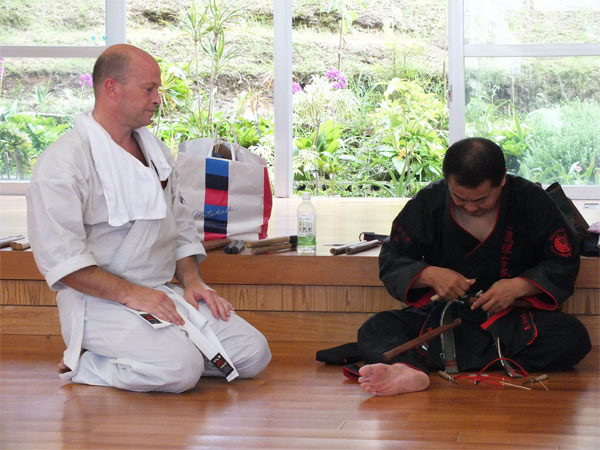 |
| The final session involved ude and ashi tanren and we all paired up for a "meet and beat" session. :)
Some the tanren were familiar as we do many in the dojo but some were specialized to Uechi Ryu. It was incredible not only how strong the Kinjo brothers were but how expertly they understood alignment when receiving each others techniques. I can't imagine a father being more proud of these talented men and they possess some of the best kobudo technique of their generation.
|
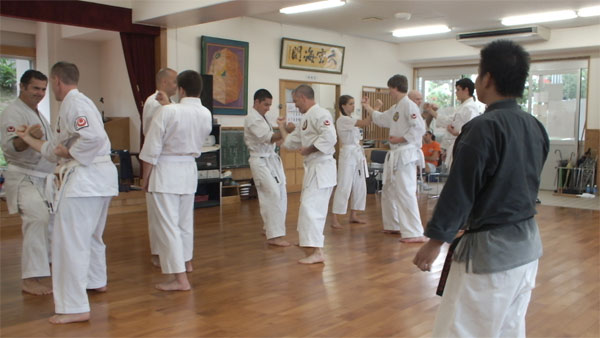 |
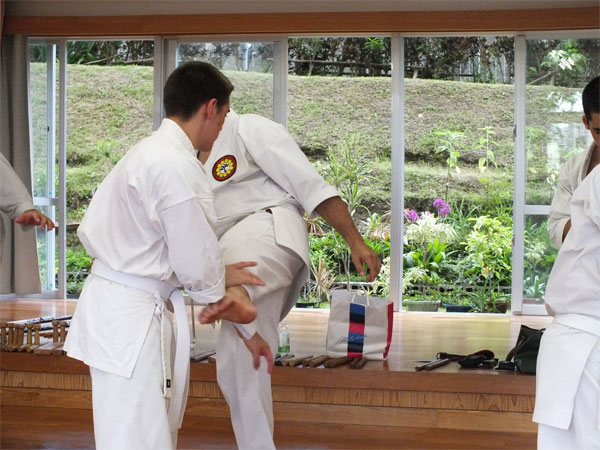 |
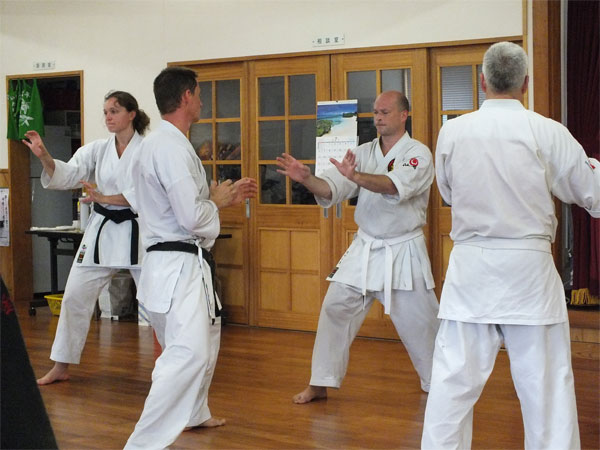 |
|
|
| At the end of the training sessions, Miguel told us that we would be seeing kobudo demonstrations by the instructors and he asked me to perform an Okinawa karate kata so that the French students could compare and contrast their Japanese karate with karate of the Ryukyus. The French team had a student perform a Shotokan kata(Jion, I think) and I performed Chinto.
Satoshi Sensei and Kenta Sensei did a brilliant bo kata performed in mirror image followed by Satoshi san demonstrating Tsuken Sunakake no Eku and his father performing a Uechi Ryu kata.
After pictures, we quickly changed and Kinjo Sensei invited us up to his home to see his kobudo collection. Over 700 nunchaku, 40 sai, 40 tonfa and countless timbe and others.
He graciously gave me a second surprise gift of his handmade replica of Taira Shinken's personal tonfa.
|
|
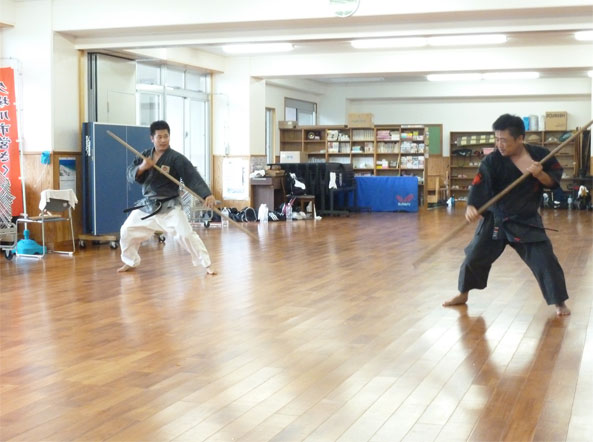 |
|
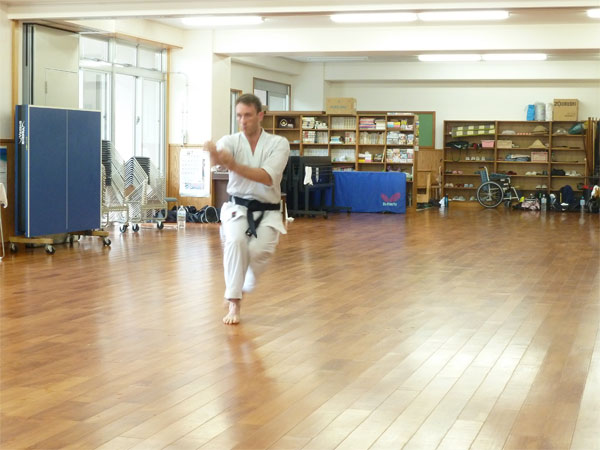 |
|
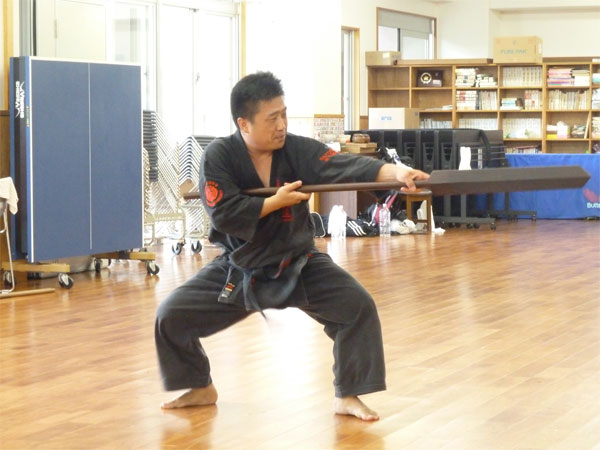 |
|
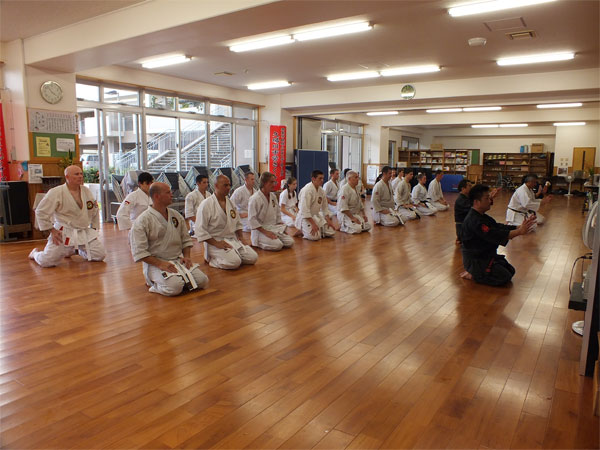 |
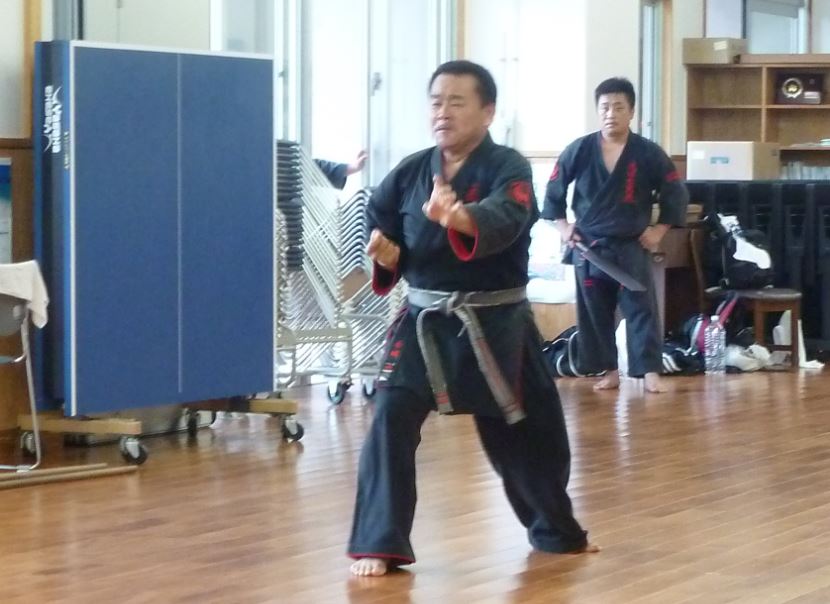 |
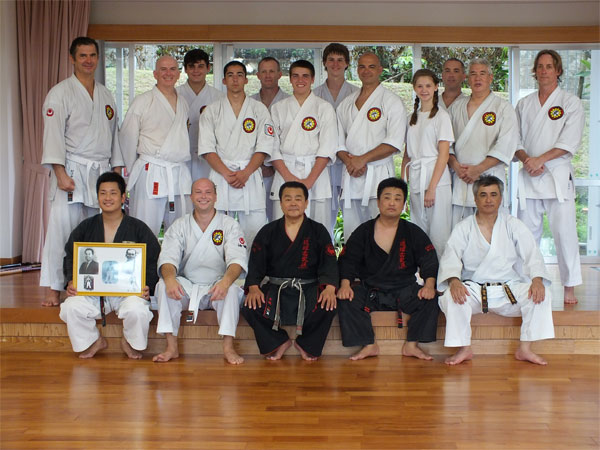 |
Gifts from Kinjo Sensei
|
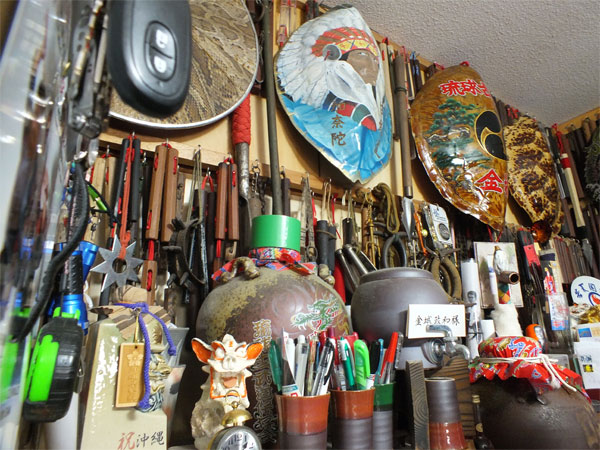 |
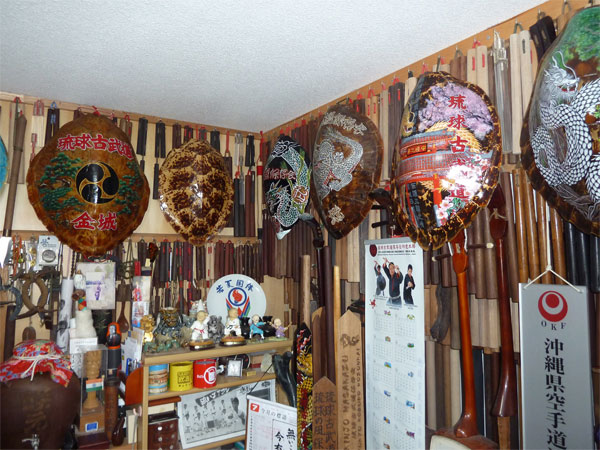 |
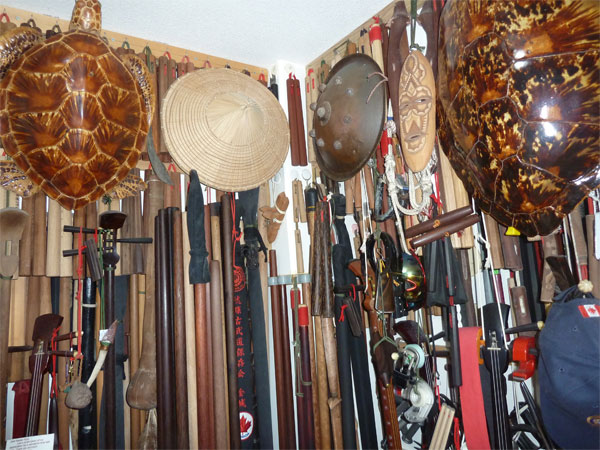 |
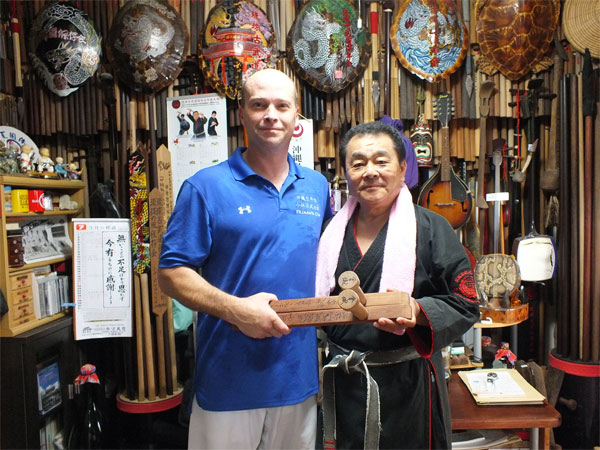 |
| Our next stop was at Daigo Sensei's new dojo/home in Ginowan, not too far from his old location. We were treated to a demonstration of his very talented students performing various kata, team kata and yakusoku kumite. Afterwards, our group partnered up with members of the dojo for an exchange of bunkai/oyo in various katas of their choice.
We were treated to a home-cooked meal of beef curry rice by one of his dojo moms and we all sat down for a well needed dinner and a chat with the members of the dojo.
|
 |
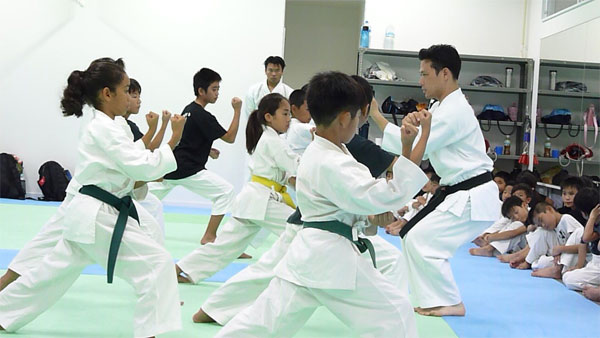 |
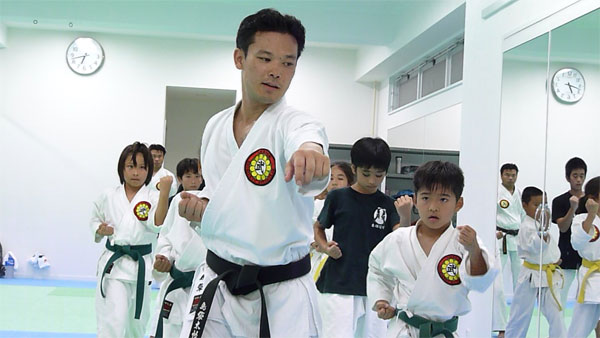 |
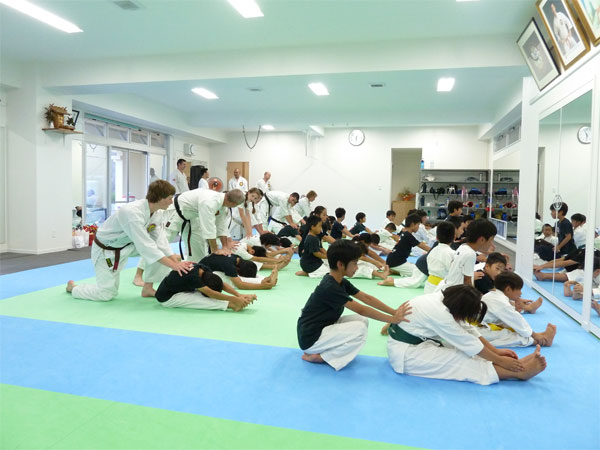 |
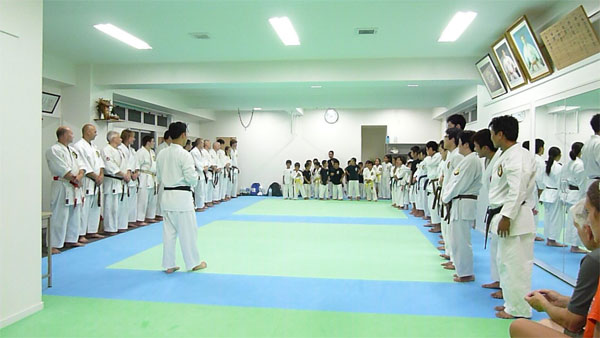 |
|
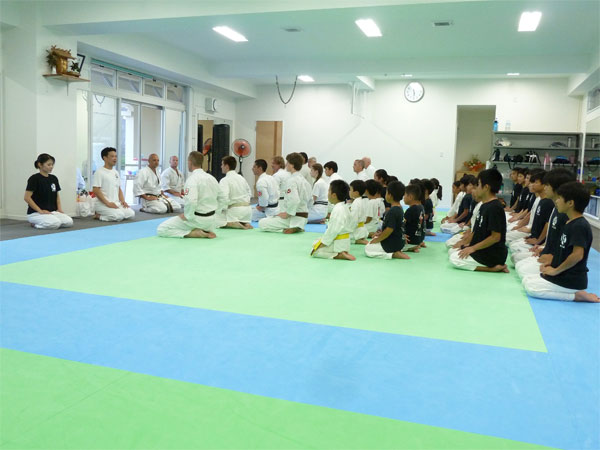 |
|
|
|
|
Saturday July 5
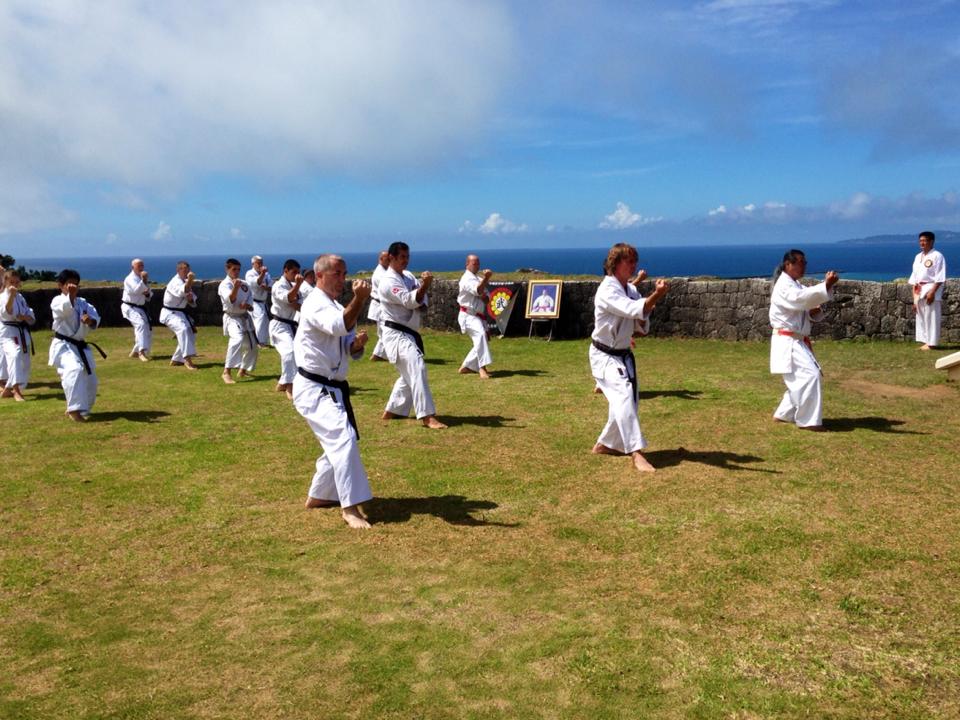
| After the passing of O'Sensei, I had a wish to say goodbye to him in a way that would honor his martial tradition but also the love he had for his island's culture. I still cherish the memory of him showing my youngest daughter pictures in a coffee table book at my home and how he showed so much pride in every description he gave to her.
And so in the months leading up to the trip, with as much gentle persistance as I could muster, I persuaded Gibu Sensei and other Butokukan members for us to gather at Katsuren Castle and conduct a memorial keiko in our teacher's honor.
I know this was an emotional struggle for all of us who were close to O'Sensei but after it was over, I think we collectively felt that he was smiling down on us. Gibu O'Sensei was a warrior and he was a man who trained alongside his students. So it was no surprise that as thankful as he might have been for the gesture of our training, he made sure it was a very hot morning so that none of us could take the easy way out. He wanted us to be warriors as well and there is no time to choose your training environment.
|
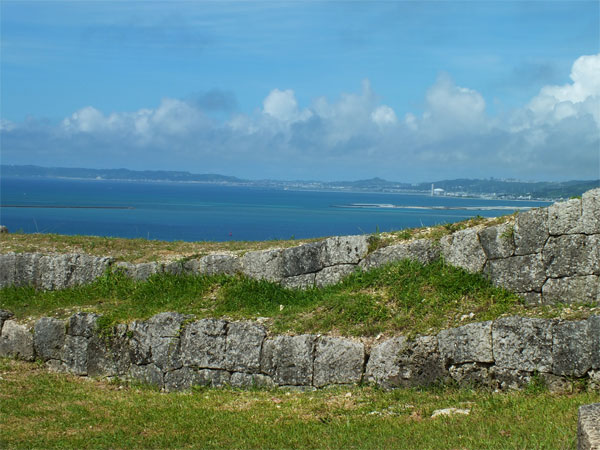 |
| There was a great amount of emotion that morning and each of us chose a personal kata to present to him. We all performed as a group Naihanchi Shodan, Tonfa no Kata(Shorinkan no Tonfa) and his personal favorite Kusanku Sho.
Afterwards, Gibu Sensei gave a short speech and with heavy hearts, we all took some quick pictures and then made our way down the hill to our cars.
Tamaki Sensei and Sunagawa Sensei took us all out to lunch in Uruma on the bridge near Hama Higa Island and we had a short time to buy some gifts to take back home.
|
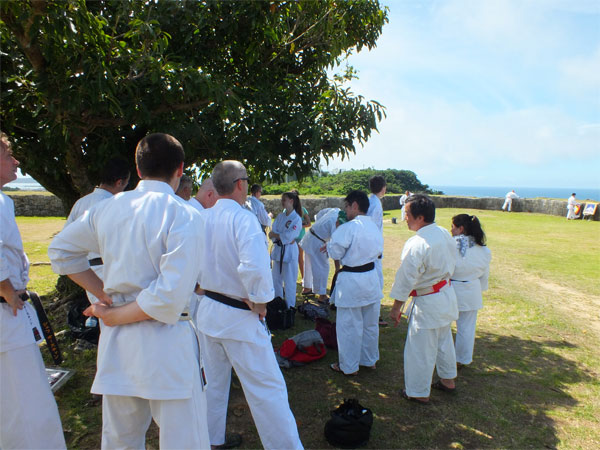 |
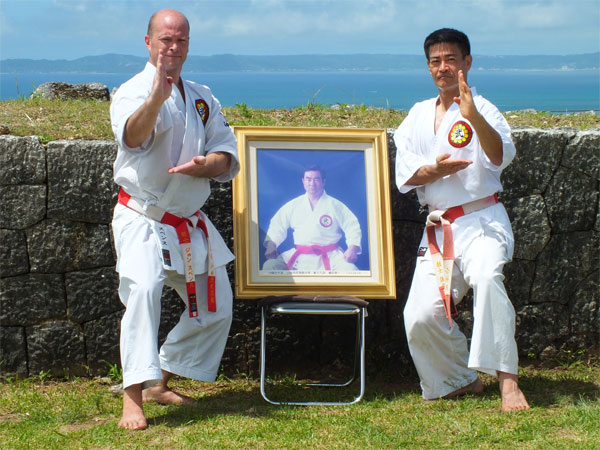 |
 |
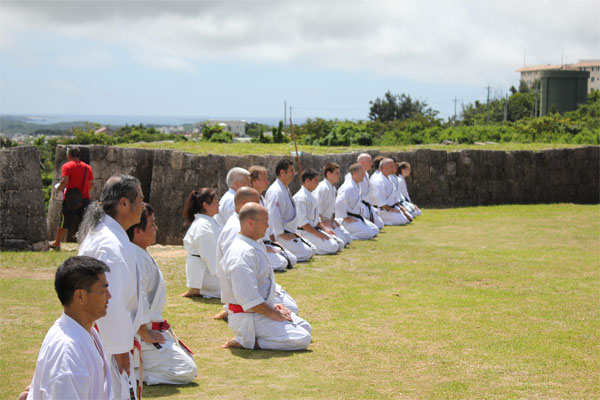 |
 |
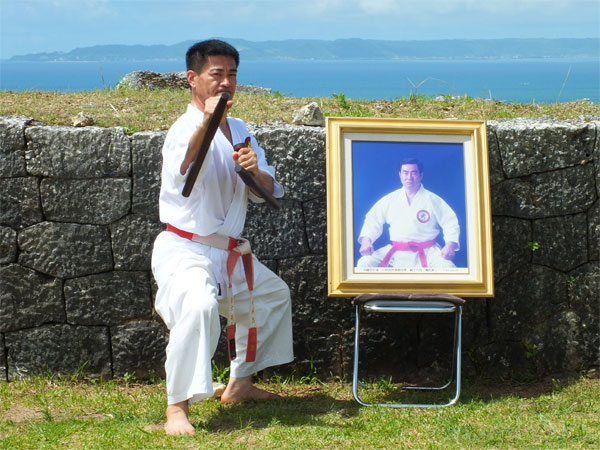 |
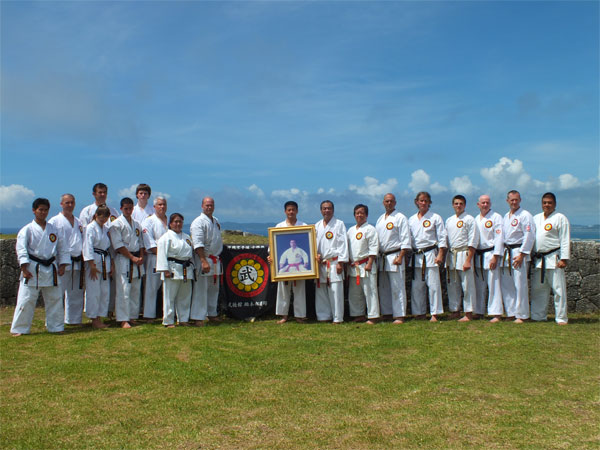 |
| After returning to the hotel, John informed us that a massive typhoon was going to strike Okinawa on Tuesday(the day we were going to leave) so I made the decision to have everyone contact the airlines and leave as soon as possible.
Izumi Sensei came to hotel around 2 pm to drive us to Mihama where he was giving us our sobetsukai(Farewell party). He had been planning this gracious party for many months and recruited Ukemasu san and Toguchi san to help with the cooking and heavy lifting.
Izumi Sensei had imported beef from Ishigaki Island that is identical to Kobe steak and brought a keg of Orion as well as a tub of enough superman juice to make us forget any bumps and bruises we had accumulated this trip.
We were situated next to the main entertainment stage for the Port Festival and were able to listen to some very talented singers. After a full contact frisbee football match in the swimming area and some fun interactions with the group in the next tent over, we were entertained with a wonderful fireworks display.
|
|
 |
 |
|
|
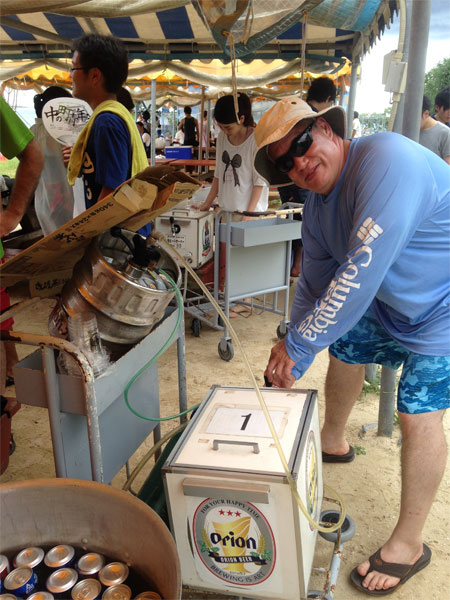 |
 |
 |
 |
| There are so many "pinch" moments that happen on our trips but sometimes it is the times outside the dojo where we spend time with our seniors that are true treasures. After dropping everyone off, Izumi Sensei took a few of us BACK out to one of his favorite izakaya restaurants where we were met by Ukemasu San and Toguchi san and we had round two of food and drinks. |
 |
|
 |
Sunday July 6
| With news of the incoming possible typhoon Neoguri, we drove most of the group to the airport the next morning so they could get off the island. A few of us were only to get later flights so we spent the day packing and making arrangements for our travel home. We had one more meal at Lemon Grass to remember our trip by and then hit the hay.
Izumi Sensei drove Joe and I to the airport the next morning where we were met by Gibu Sensei who treated us to coffee and a snack before we headed to the gate.
|
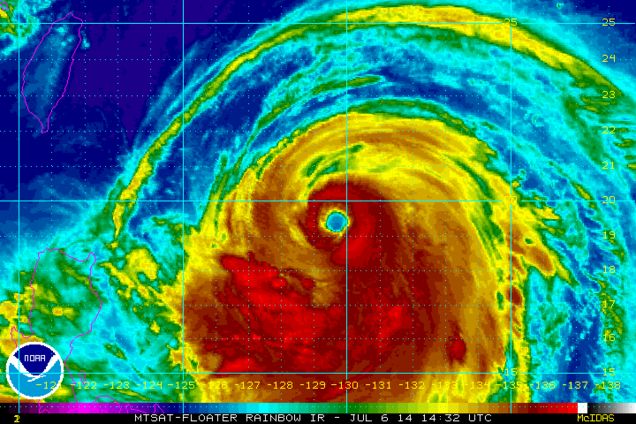 |
| After returning, many people have asked how this journey went and with mixed emotions I have told them the truth. This trip was personally an emotional struggle as it was filled with moments of joy.
The feeling of sadness for the loss of my teacher was equaled by the proud feeling I had of my students and other members of our group. Once back in the states, people would remark with amazement that "how difficult it must have been to take 20 people!" My response was that you could not have taken a better group of individuals and the trip was amazing because of them.
I hope that they will all be as changed by the trip to Okinawa as I always am.
|
|
|
|
Contents Copyright © 2017 Shorin-Ryu Shorinkan Karate of Williamsburg
Click Here to Return to the Shorin-Ryu Shorinkan Karate Home Page
|
 |

